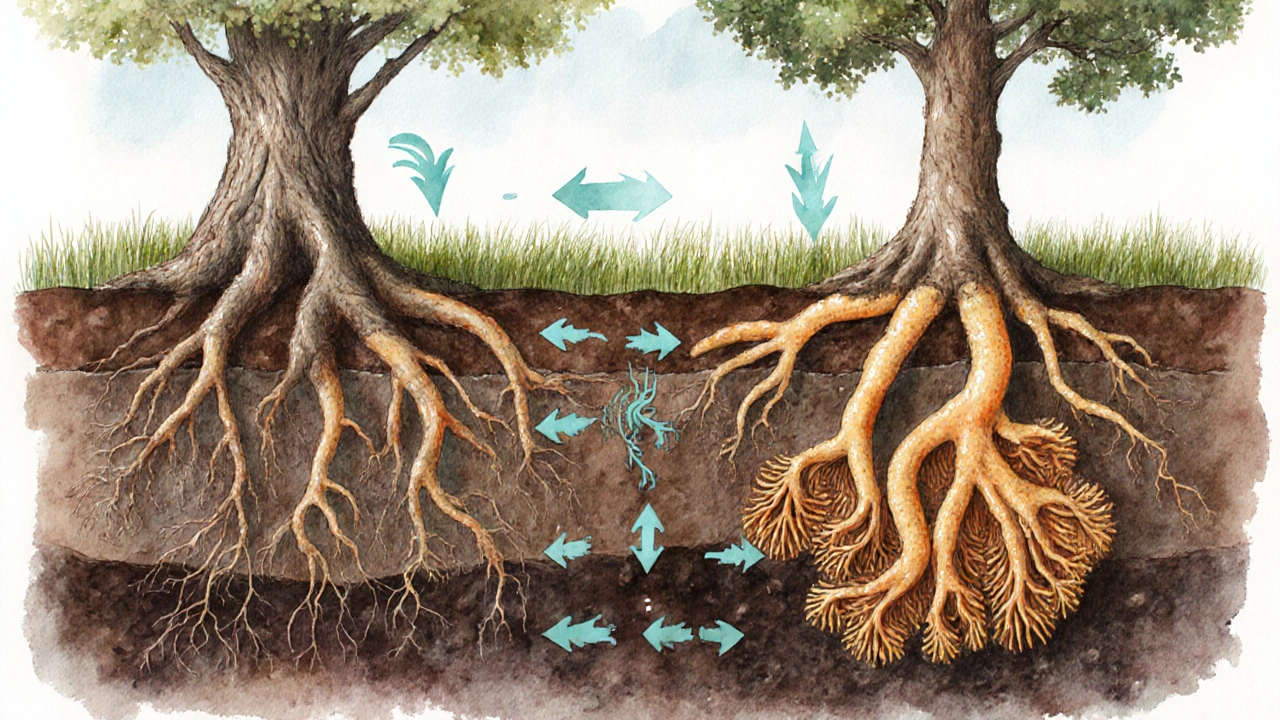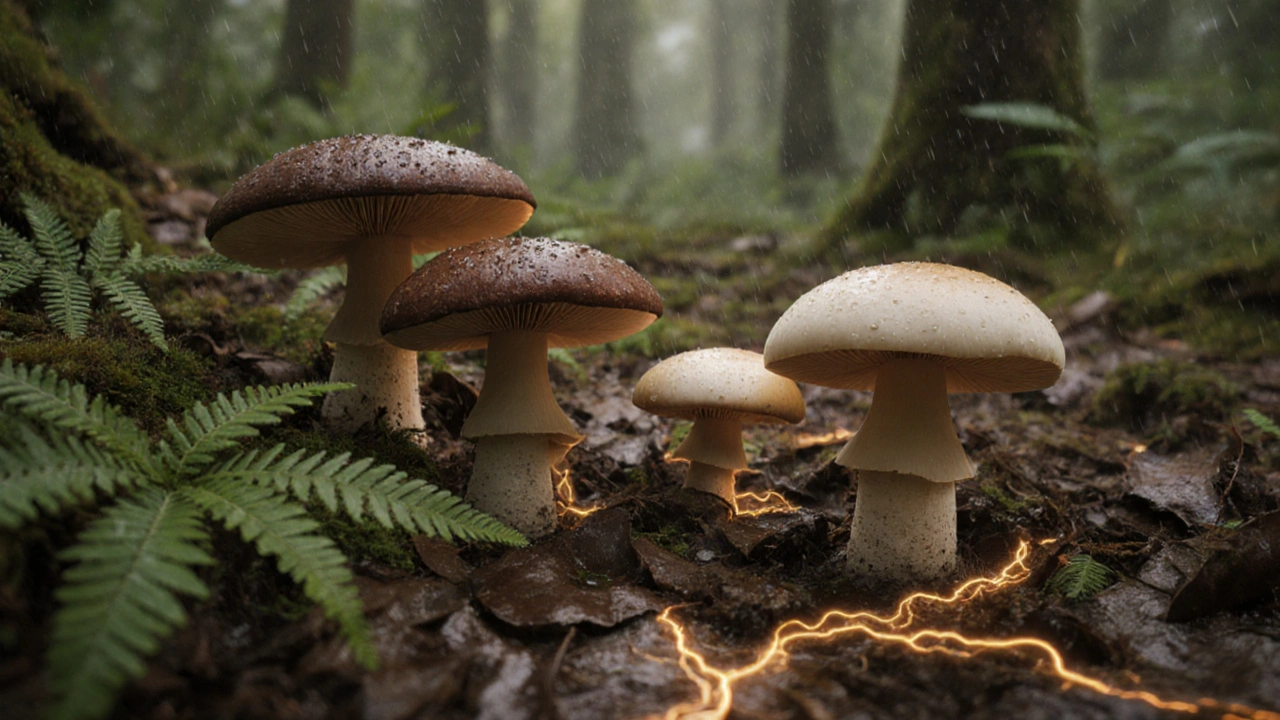- 17
Forest Carbon Storage Estimator
This tool estimates how much carbon can be stored in forest soil based on forest type and management practices.
Ever wonder why a forest smells earthy after rain? That scent comes from Fungi a kingdom of organisms that break down dead material and form hidden partnerships with plants. Those tiny workers are a powerhouse in the Carbon Cycle the planet‑wide system that moves carbon between the air, living things, and the ground. Understanding what they do helps explain everything from soil health to climate change.
Quick Takeaways
- Fungi turn dead wood and leaf litter into soil carbon.
- Mycorrhizal fungi transport carbon from plants into the underground network.
- About 20‑30% of carbon flowing through forests passes through fungal pathways.
- Changing temperatures can speed up fungal decomposition, releasing more CO₂.
- Managing fungal communities is a new tool for carbon‑storage projects.
Why Fungi Matter in the Carbon Cycle
Carbon starts its journey in the air as CO₂. Photosynthesis the process plants use to turn CO₂ and sunlight into sugars pulls that gas into living tissue. When leaves fall or trees die, the carbon is locked in dead matter. That’s where fungi step in.
Through Decomposition the breakdown of organic material by microbes, fungi release carbon back as CO₂ or store it in soil as organic matter. Roughly a third of the carbon that leaves the atmosphere each year in forested regions is processed by fungal decomposers.
But fungi don’t just act on dead stuff. Mycorrhizae mutualistic fungi that connect plant roots to soil form an underground highway. Plants hand over up to 20% of the sugars they make to these allies, and in return the fungi deliver water, nutrients, and-crucially-extra carbon deep into the soil where it can stay for decades.
Fungal Decomposition: Turning Waste into Soil Carbon
When a pine needle lands on the forest floor, a crew of saprotrophic fungi colonizes it. Their enzymes-cellulases, ligninases, and others-break the tough plant fibers into smaller molecules. Some of those molecules are respired as CO₂, but a sizable portion becomes humus, the dark, stable component of soil that holds carbon tightly.
Scientists estimate that in temperate forests, saprotrophic fungi sequester between 0.3 and 0.7 petagrams of carbon each year. That number jumps in tropical rainforests, where rapid turnover and high fungal diversity keep the ground rich in organic matter.
Mycorrhizal Networks: Carbon Highways Below Ground
There are two main mycorrhizal groups: arbuscular mycorrhizae (AM) and ectomycorrhizae (ECM). AM fungi dominate in grasslands and many crops, while ECM fungi are common in boreal and temperate forests.
Both types receive carbon from host plants, but they handle it differently. AM fungi tend to recycle most of the carbon quickly, whereas ECM fungi can store carbon in their thick, hyphal mats for years. Those mats act like a sponge, trapping organic matter and slowing its return to the atmosphere.
Recent field studies using isotopic labeling show that up to 40% of the carbon transferred to ECM fungi ends up locked in the surrounding soil. That makes mycorrhizal fungi one of the most efficient natural carbon‑storage mechanisms we know.

Climate Change Feedbacks: When Heat Speeds Up Fungi
Warmer temperatures boost fungal metabolism. A 2°C rise can increase decomposition rates by 15‑30%, meaning more CO₂ leaves the soil faster. That creates a feedback loop: higher CO₂ fuels more plant growth, which creates more litter, which fuels faster fungal breakdown.
However, not all fungi respond the same. Some cold‑adapted species slow down, while heat‑loving ones thrive. This shift can change the balance between carbon release and storage, altering regional carbon budgets.
Managing Fungal Communities for Better Carbon Outcomes
Land managers are now looking at ways to harness fungi. Here are three practical approaches:
- Reduced Tillage: Leaving soil undisturbed preserves mycorrhizal networks and lets saprotrophs build up humus.
- Inoculation: Adding selected ECM fungi to reforested sites can jump‑start carbon sequestration.
- Organic Amendments: Adding wood chips or biochar supplies substrate for saprotrophs, boosting long‑term soil carbon.
When these tactics are combined with good tree species selection, forests can lock away extra carbon for centuries.
Key Numbers at a Glance
| Process | Typical Carbon Flux (PgC/yr) | Primary Fungal Group | Storage Duration |
|---|---|---|---|
| Leaf litter decomposition | 0.4‑0.6 | Saprotrophic fungi | Months‑years |
| Wood decay in forests | 0.7‑1.0 | Saprotrophic fungi | Years‑decades |
| Carbon transfer via mycorrhizae | 0.3‑0.5 | ECM & AM fungi | Decades‑centuries |
| Soil organic carbon accumulation | 0.2‑0.4 | All fungal groups | Centuries |
Future Research Directions
Scientists are still mapping the fungal genome to predict which species store the most carbon. New remote‑sensing tools can estimate fungal biomass from space, giving a global view of how fungal activity changes with climate.
Another hot topic is the interaction between fungi and soil microbes like bacteria. Some bacteria accelerate carbon loss, while others help lock it in. Understanding that partnership could unlock smarter carbon‑management strategies.
Frequently Asked Questions
How do fungi actually capture carbon?
Fungi don’t pull CO₂ directly from the air. They receive carbon from plant sugars (through mycorrhizae) or from dead organic matter (through decomposition). That carbon is either respired as CO₂ or turned into stable compounds that become part of the soil.
Can planting more trees increase fungal carbon storage?
Yes. More trees mean more root exudates that feed mycorrhizal fungi, and more leaf litter for saprotrophs. Both pathways boost the amount of carbon that ends up in the soil.
Do all fungi store carbon the same way?
No. Saprotrophic fungi mainly break down material and release CO₂, while mycorrhizal fungi often move carbon deeper into the ground where it can stay for decades.
What happens to fungal carbon storage as the climate warms?
Warming generally speeds up fungal metabolism, leading to faster CO₂ release. Some heat‑loving fungi can still store carbon, but the overall balance often tips toward more emission.
How can landowners encourage beneficial fungi?
Practices like reduced tillage, adding wood chips, planting native trees, and even inoculating soils with mycorrhizal spores can boost the fungal community that locks carbon in the ground.


chioma uche
September 30, 2025 AT 22:17Fungi are the hidden heroes of our soil, and Africa should lead the world in harnessing them!
Satyabhan Singh
October 1, 2025 AT 17:44The intricate role of fungi in terrestrial carbon dynamics warrants meticulous scholarly attention.
Fungal saprotrophs decompose lignocellulosic substrates, thereby converting complex polymers into simpler organic molecules.
These molecules may either be mineralized as CO₂ or incorporated into stable humic substances within the soil matrix.
Mycorrhizal symbioses represent a bidirectional carbon conduit, wherein photosynthates are allocated to fungal hyphae in exchange for mineral nutrients.
Empirical investigations have quantified that approximately twenty to thirty percent of net primary productivity transits through mycorrhizal networks.
Moreover, ectomycorrhizal hyphal mats can sequester carbon for decadal timescales, surpassing the turnover rates of many bacterial metabolites.
Climate warming induces enzymatic acceleration in fungal metabolisms, potentially augmenting respiration rates by fifteen to thirty percent per two degrees Celsius.
This thermally mediated feedback may diminish the net carbon sink strength of temperate forests.
Nevertheless, the compositional shift toward thermophilic fungal taxa could partially offset such losses.
Forest management practices, such as reduced tillage, preserve hyphal continuity and foster organic matter accumulation.
Inoculation with selected ectomycorrhizal strains has demonstrated measurable increments in soil carbon stocks under controlled experimental conditions.
The integration of remote sensing technologies with phylogenetic profiling promises to elucidate global patterns of fungal biomass.
Interactions between fungi and bacterial consortia further modulate carbon stabilization processes, a frontier deserving of interdisciplinary inquiry.
Consequently, policy frameworks aimed at climate mitigation should incorporate fungal dynamics as a pivotal component.
In sum, advancing our comprehension of fungal-mediated carbon fluxes is essential for devising resilient ecological strategies.
Keith Laser
October 2, 2025 AT 13:10Oh great, another article telling us fungi are the "secret saviors" of the planet-like we didn’t already know microbes do stuff. Guess we’ll just sprinkle some spores on everything and call it a day.
Winnie Chan
October 3, 2025 AT 08:37Honestly, it’s kinda cool how those tiny networks are pulling carbon around underground. Makes you appreciate the forest floor a bit more, doesn’t it?
Kyle Rensmeyer
October 4, 2025 AT 04:04yeah but who’s really watching these fungi? 🤔 never seen a mushroom on the news 😂
Rod Maine
October 4, 2025 AT 23:30i dont think u r gettin it, fungi r like the brainiacs of the soil ecosystem and u still talking like its a hobby.
Othilie Kaestner
October 5, 2025 AT 18:57Sure, let’s all bow down to spores while ignoring the real carbon culprits-humans! If only we could outsource our emissions to mushrooms, the world would be fine.
Sebastian Samuel
October 6, 2025 AT 14:24🌱💚 I love how fungi are the silent workers under our feet. They’re literally the unsung heroes of carbon storage! 🌍✨
Mitchell Awisus
October 7, 2025 AT 09:50Indeed! The article does a solid job highlighting the mechanisms, but I’d add that practical implementation-like inoculating reforested sites-needs more field trials. Also, the interplay with bacterial decomposers can either accelerate or inhibit carbon sequestration, depending on community composition. Therefore, a holistic approach that monitors both fungal and bacterial dynamics will likely yield the most accurate forecasts for long‑term soil carbon stability.
Annette Smith
October 8, 2025 AT 05:17Fungi break down dead leaves and wood, turning them into soil that stores carbon for a long time.
beth shell
October 9, 2025 AT 00:44That’s a clear way to look at it, thanks for the simple explanation.
khushali kothari
October 9, 2025 AT 20:10From a mycological perspective, the enzymatic repertoire of saprotrophic basidiomycetes-particularly lignin peroxidases and manganese peroxidases-facilitates the depolymerization of recalcitrant lignocellulosic matrices, thereby catalyzing fluxes of carbon into humic fractions. Moreover, the ectomycorrhizal symbiosis modulates host carbon allocation through intricate signaling pathways, influencing both C‑N stoichiometry and isotopic fractionation within the rhizosphere.
Brandon Smith
October 10, 2025 AT 15:37While the science is compelling, we must not forget that humanity’s reckless exploitation of forests undermines these natural processes. Ethical stewardship is not optional; it is a moral imperative.
darwin ambil
October 11, 2025 AT 11:04🌍💡 Fun fact: adding wood chips can boost fungal activity, which in turn locks more carbon underground! 👍🍄
Kelvin Van der Maelen
October 12, 2025 AT 06:30Wow, so the fungi are basically the drama queens of the ecosystem-always stealing the spotlight and leaving us with the real mess!
Joy Arnaiz
October 13, 2025 AT 01:57In a world increasingly driven by sensationalism, the subtle yet profound contributions of fungal networks demand our utmost respect and scholarly attention, lest we overlook a cornerstone of planetary resilience.
Christopher Eyer
October 13, 2025 AT 21:24The article is good but it could be better. I think the authors missed some key data on how fungi interact with soil microbes. This oversight could mislead policy makers and reaserchers alike.